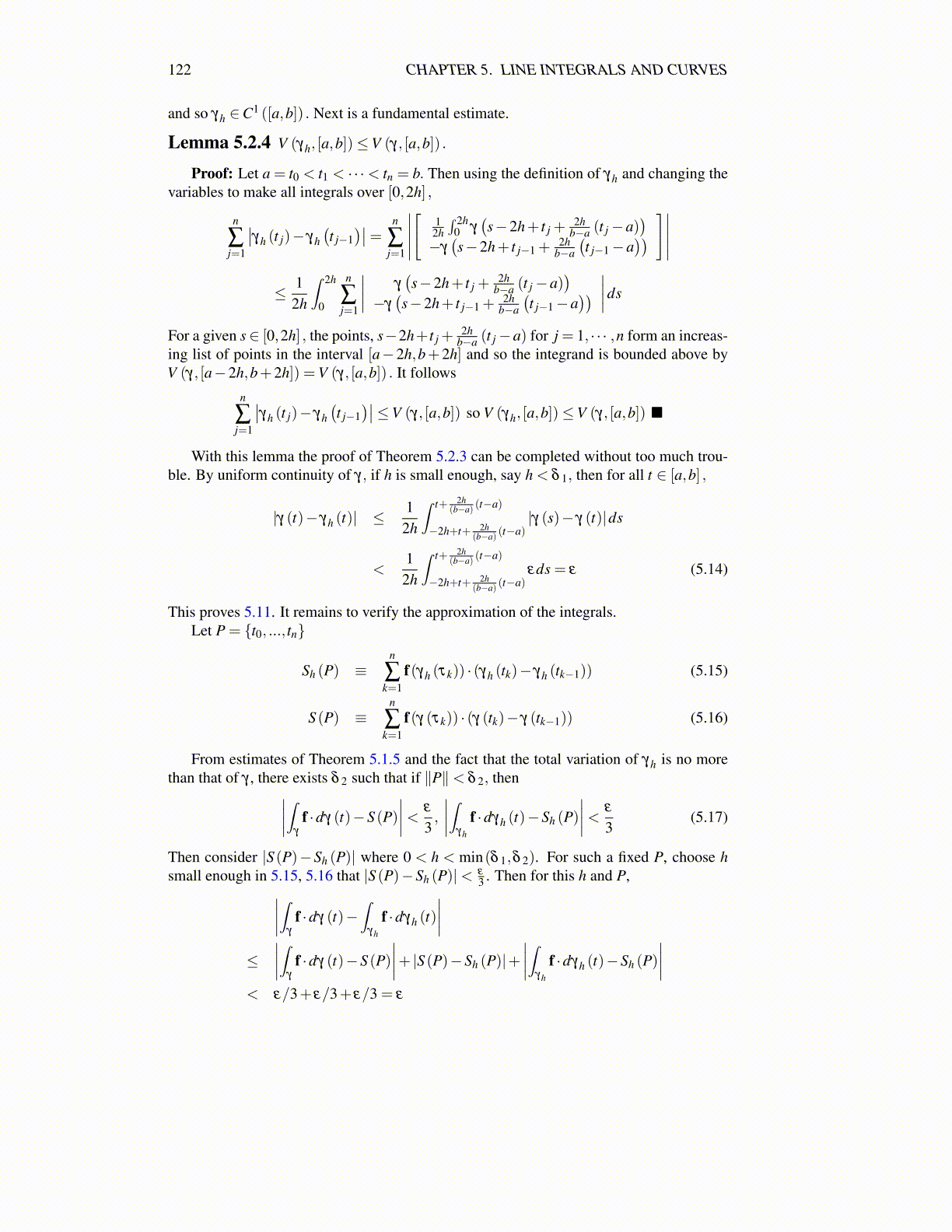
122 CHAPTER 5. LINE INTEGRALS AND CURVES
and so γh ∈C1 ([a,b]) . Next is a fundamental estimate.
Lemma 5.2.4 V (γh, [a,b])≤V (γ, [a,b]) .
Proof: Let a = t0 < t1 < · · ·< tn = b. Then using the definition of γh and changing thevariables to make all integrals over [0,2h] ,
n
∑j=1
∣∣γh (t j)− γh(t j−1
)∣∣= n
∑j=1
∣∣∣∣∣[
12h∫ 2h
0 γ(s−2h+ t j +
2hb−a (t j−a)
)−γ(s−2h+ t j−1 +
2hb−a
(t j−1−a
)) ]∣∣∣∣∣≤ 1
2h
∫ 2h
0
n
∑j=1
∣∣∣∣ γ(s−2h+ t j +
2hb−a (t j−a)
)−γ(s−2h+ t j−1 +
2hb−a
(t j−1−a
)) ∣∣∣∣ds
For a given s∈ [0,2h] , the points, s−2h+ t j +2h
b−a (t j−a) for j = 1, · · · ,n form an increas-ing list of points in the interval [a−2h,b+2h] and so the integrand is bounded above byV (γ, [a−2h,b+2h]) =V (γ, [a,b]) . It follows
n
∑j=1
∣∣γh (t j)− γh(t j−1
)∣∣≤V (γ, [a,b]) so V (γh, [a,b])≤V (γ, [a,b]) ■
With this lemma the proof of Theorem 5.2.3 can be completed without too much trou-ble. By uniform continuity of γ, if h is small enough, say h < δ 1, then for all t ∈ [a,b] ,
|γ (t)− γh (t)| ≤1
2h
∫ t+ 2h(b−a) (t−a)
−2h+t+ 2h(b−a) (t−a)
|γ (s)− γ (t)|ds
<1
2h
∫ t+ 2h(b−a) (t−a)
−2h+t+ 2h(b−a) (t−a)
εds = ε (5.14)
This proves 5.11. It remains to verify the approximation of the integrals.Let P = {t0, ..., tn}
Sh (P) ≡n
∑k=1
f(γh (τk)) · (γh (tk)− γh (tk−1)) (5.15)
S (P) ≡n
∑k=1
f(γ (τk)) · (γ (tk)− γ (tk−1)) (5.16)
From estimates of Theorem 5.1.5 and the fact that the total variation of γh is no morethan that of γ , there exists δ 2 such that if ∥P∥< δ 2, then∣∣∣∣∫
γ
f ·dγ (t)−S (P)∣∣∣∣< ε
3,
∣∣∣∣∫γh
f ·dγh (t)−Sh (P)∣∣∣∣< ε
3(5.17)
Then consider |S (P)−Sh (P)| where 0 < h < min(δ 1,δ 2). For such a fixed P, choose hsmall enough in 5.15, 5.16 that |S (P)−Sh (P)|< ε
3 . Then for this h and P,∣∣∣∣∫γ
f ·dγ (t)−∫
γh
f ·dγh (t)∣∣∣∣
≤∣∣∣∣∫
γ
f ·dγ (t)−S (P)∣∣∣∣+ |S (P)−Sh (P)|+
∣∣∣∣∫γh
f ·dγh (t)−Sh (P)∣∣∣∣
< ε/3+ ε/3+ ε/3 = ε